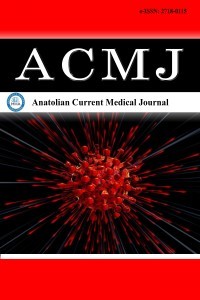
Anatolian Current Medical Journal
Yazarlar: ["Nazlı KORKMAZ", "İbrahim ALATAŞ", "Alev ATEŞ AYDIN", "Ali EKİZ", "Necdet ÖNCÜ"]
Konular:-
DOI:10.38053/acmj.1170709
Anahtar Kelimeler:Cerebellar malformation,Cerebellar hypoplasia,Vermis hypoplasia,Pregnancy,Termination
Özet: Introduction: Fetal cerebellar malformations (FCM) are known as very rare central nervous system malformations that occur as hypoplasia or agenesis of the cerebellum or vermis. In this study, the characteristics, diagnostic methods, risk factors and management of pregnant women diagnosed with FCM in the prenatal period were investigated. Material and Method: The patients who diagnosed with prenatal FCM in the perinatology center between March 2017-February 2021 were included, retrospectively. The frequency of fetal magnetic resonance imaging (MRI), amniocentesis and/or karyotype analysis rates, and termination frequency were evaluated. In addition, the factors affecting the amniocentesis and the termination/follow-up decision were investigated. Results: A total of 42 pregnant with FCM were included. The median gestational age was 24.0 years, and the mean gestational week was 25+2 (SD±5+1) weeks. Nearly half (40.5%) of patients were diagnosed before 24 weeks of gestation and 45.2% were primiparous. Cerebellar hypoplasia was observed in 47.6%, while vermis agenesis was observed in almost one third (31.0%); and also 19.0% had multiple FCM. The fetal USG was used in all pregnant women, fetal MRI was performed in only 4.8% for diagnosis of FCM. The rate of amniocentesis and karyotype analysis were 11.9% and 7.1%, retrospectively. No any complications were observed after the amniocentesis. The termination rate was 30.9%. The mean gestational week of those who had live birth was higher than those who were terminated (24+4 vs 20+5) (p=0.019). Conclusion: The frequency of FCM diagnosis has increased with the development of modern medicine and technology. There is no relationship between demographic characteristics of pregnant women and FCM. Socio-economic levels and religious belief differences affect the termination and birth rates.